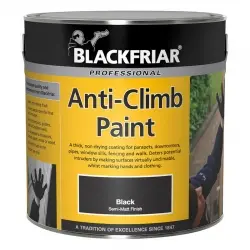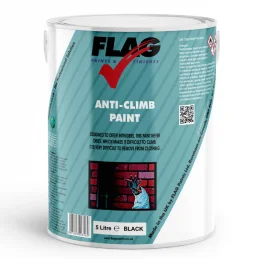- There are no more items in your cart
- Shipping Calculated at checkout
- Sub-Total (inc. VAT) £0.00
Need Help?
Anti-Climb Paints
Anti-climb paint is an innovative and highly effective solution designed to prevent unauthorised access to buildings, structures, and various properties. This thick, non-drying coating creates a slippery surface that deters potential intruders by making it nearly impossible to gain a foothold. In addition, the paint marks anyone who comes into contact with it, aiding in the identification of trespassers. Anti-climb paint is versatile, suitable for use across different sectors, and is an essential component of any comprehensive security strategy. Click to see more info.
Subcategories

Coo-Var Vandalene Anti Climb Paint
Non-drying product designed to create a slippery surface. For window ledges, downpipes, walls, gutters, and any surface that could be used as a grip point. Semi-matt finish with a grease-like viscosity. Ideal as a deterrent.

Blackfriar Professional Anti Climb Paint
Blackfriar Professional Anti Climb Paint is a thick, non-drying coating for parapets, downcomers, pipes, window sills, fencing and walls. Deters potential intruders by making surfaces virtually unclimable, whilst marking hands and clothing. An effective deterrent.Pigmented petroleum wax Slippery, non-drying finish Ideal for drainpipes,...

Flag Anti Climb Security Paint
Flag Anti Climb Security Paint is a thick glutinous coating, similar to smooth gloss paint in appearance but when applied remains slippery indefinitely preventing any intruder from gaining a foothold. An effective deterrent, this product never fully dries making surfaces difficult to climb.For exterior use on brick, cement, wood, metal,...
Need Help?
Need Help?
Understanding Anti-Climb Paint
Anti-climb paint, often referred to as anti-vandal paint or security paint, is a thick, greasy substance that remains perpetually slippery. Unlike regular paint, it never fully dries, maintaining its tacky texture indefinitely. This quality makes it an effective deterrent for anyone attempting to scale walls, fences, drainpipes, or other potential access points. The paint is typically only available in black.
The application of anti-climb paint is straightforward, requiring a stiff brush, trowel, or protective gloves. It adheres well to most surfaces, including brick, wood, metal, and concrete. Once applied, it continues to perform regardless of weather conditions, making it a reliable choice for long-term security.
Where and Why Anti-Climb Paint is Used
Anti-climb paint serves a variety of purposes across multiple sectors. Its primary function is to enhance security by preventing unauthorised access. Whether it’s to deter burglars, vandals, or trespassers, this paint is a cost-effective solution that can be applied to various structures.
Residential Properties
In domestic settings, homeowners use anti-climb paint to safeguard their properties. It is commonly applied to garden walls, fences, gates, and drainpipes, providing an extra layer of protection against break-ins. For example, a homeowner might apply the paint to the top of their garden fence and drainpipes to prevent burglars from gaining access to upper floors.
Commercial Properties
Businesses often use anti-climb paint to secure vulnerable points of entry, such as rear access doors, loading bays, and perimeter walls. A retail store, for instance, might apply the paint to the top of its exterior walls and downpipes to prevent thieves from climbing onto the roof. Additionally, warehouses and storage facilities benefit from its application on gates, fencing, and even machinery, reducing the risk of theft and vandalism.
Public and Municipal Use
Local councils and public institutions use anti-climb paint to protect public buildings, monuments, and recreational areas from vandalism. A common example is its application on playground equipment, statues, and building exteriors. This not only deters potential damage but also reduces maintenance costs. For instance, a council might use the paint on the roof of a community centre to prevent individuals from climbing onto it and causing damage.
Industrial Sites
Industrial settings, including factories, power plants, and construction sites, are high-risk areas where security is paramount. Anti-climb paint is used extensively on perimeter fences, scaffolding, and access points. A construction site, for instance, may apply the paint to scaffolding and temporary fencing to prevent unauthorised access, especially after hours when the site is unmanned. Industrial facilities also use the paint on pipelines, storage tanks, and even on transport containers to ensure they remain secure from intruders.
Animal Safety Considerations
While anti-climb paint is primarily designed to deter human intruders, it’s also worth considering its effects on animals. The paint is generally non-toxic, but it is important to note that it should be applied in areas that are unlikely to be accessed by wildlife or domestic animals. In residential areas, homeowners should ensure that pets do not come into contact with the paint, as it can cause irritation and is difficult to remove from fur. For example, applying the paint only to the upper sections of walls and fences—above the reach of animals—can help mitigate any potential risk.
Legal and Safety Considerations
When using anti-climb paint, it is essential to comply with legal requirements to avoid potential liability issues. In the UK, the paint should not be applied below a height of 2 metres (approximately 6.5 feet) to prevent accidental contact by the public. Additionally, it is mandatory to display clear warning signs indicating that anti-climb paint has been used. These signs serve not only as a legal requirement but also as an additional deterrent.
Failure to follow these guidelines could result in legal complications, particularly if someone inadvertently comes into contact with the paint. Moreover, non-compliance can affect insurance claims and public liability cover, which could have financial consequences in the event of a dispute or accident.
Practical Examples Across Different Sectors
- Domestic Use: A homeowner applies anti-climb paint to the tops of their boundary walls and drainpipes to prevent burglars from climbing into the property. They ensure that the paint is applied above 2 metres and that warning signs are clearly visible to avoid any legal issues.
- Commercial Use: A retail business applies anti-climb paint to the roof access points and rear walls to prevent thieves from gaining entry via the roof. The store ensures that all areas treated with the paint are marked with warning signs to comply with legal requirements.
- Public Sector: A local council uses anti-climb paint on playground equipment and statues in a public park to protect them from vandalism. Signs are posted around the park to inform the public and reduce the risk of accidental contact.
- Industrial Use: A factory secures its perimeter by applying anti-climb paint to the exterior walls, fencing, and around key access points like loading bays. The factory management also ensures that all treated areas are above 2 metres and properly signposted to prevent any legal or insurance complications.
- Animal Safety: On a rural property, anti-climb paint is used on high fence posts to prevent human intruders, while lower sections remain untreated to ensure that livestock and pets are not affected. This approach ensures the safety of animals while maintaining property security.
Anti-Climb Paint FAQs
What is anti-climb paint?
Anti-climb paint is a thick, non-drying coating that creates a slippery surface, making it difficult for intruders to climb over walls, fences, or other structures.
Where can anti-climb paint be used?
Anti-climb paint can be used on various surfaces such as brick, metal, wood, and cement. It is suitable for walls, fences, drainpipes, gutters, and more.
Is anti-climb paint legal in the UK?
Yes, it is legal, but it must be applied above 2 metres from the ground and accompanied by clear warning signs.
Does anti-climb paint dry?
No, it remains sticky and slippery indefinitely to prevent intruders from gaining a foothold.
Can anti-climb paint be used on residential properties?
Yes, it is commonly used on residential properties to enhance security on fences, walls, and drainpipes.
How long does anti-climb paint last?
Anti-climb paint remains effective as it does not dry or lose its slippery quality over time.
What colours are available for anti-climb paint?
It is currently only available in black at Rawlins Paints, with other colours recently discontinued.
How do I apply anti-climb paint?
The paint can be applied using a stiff brush, trowel, or by hand with protective gloves, on clean and stable surfaces.
What safety precautions should I take when using anti-climb paint?
Always wear protective clothing and gloves during application, and ensure that warning signs are clearly displayed afterward.
Is anti-climb paint safe for animals?
While generally non-toxic, the paint should be applied in areas where animals are unlikely to come into contact with it to prevent irritation.
For more information on anti-theft paints and coatings or to find out which product is ideal for your needs, don’t hesitate to get in touch with our Technical Team.
The information provided above is a basic overview and is intended as general information only. It is not advice, and is given without warranty. You should always refer to the relevant data sheets and our Technical Team prior to purchase or use of any products.
